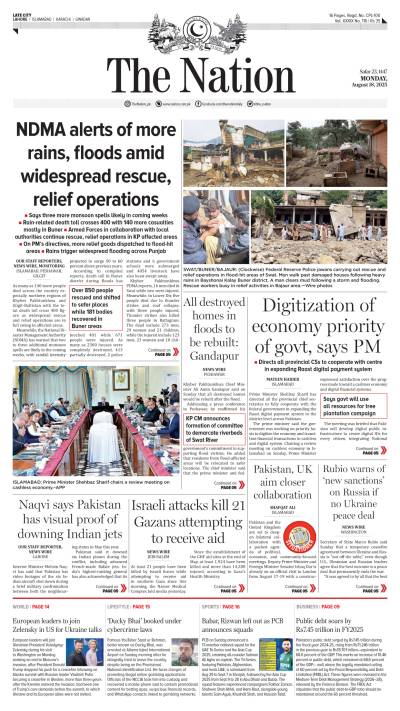The National Disaster Management Authority (NDMA) on Sunday warned of three more intense monsoon spells, cautioning that rainfall could be 50 percent heavier than usual, significantly raising the risk of urban flooding in major cities including Lahore, Rawalpindi, Islamabad, and Gujranwala.
NDMA Chairman Lieutenant General Inam Haider, briefing the media on rain-related damages, confirmed that 313 people had died in Buner, Bajaur, and Battagram due to torrential rains, while flash floods and tourist accidents in Gilgit-Baltistan pushed the nationwide death toll beyond 400. Search operations for missing persons were continuing, he added.
General Inam said several areas of Gilgit-Baltistan and Khyber Pakhtunkhwa had been cut off after landslides damaged key roads. Relief supplies and food would be dispatched to the affected districts, while a nationwide survey, ordered by the Prime Minister, would assess damages with priority given to restoring communications infrastructure. Relief packages will begin reaching the worst-hit areas from Monday, he noted.
He emphasized that the growing severity of monsoon expected to last until early September is linked to climate change, with this year’s rainfall already showing 50 percent greater intensity due to extreme summer heat. Infrastructure rehabilitation, he said, will be carried out in coordination with the Ministries of Communications and Housing once the current spell subsides.
Providing a technical outlook, NDMA expert Dr. Tayyab Shah said the ongoing monsoon system would persist until August 22 with greater intensity, while three additional weather systems, including one from the Bay of Bengal and another from Afghanistan’s Nangarhar and Kandahar regions, are moving toward Pakistan.
NDMA General Manager Zahra Hassan warned that Tarbela Dam is already at 98 percent capacity, raising the risk of dangerous water-level surges in the coming 24 to 48 hours. She said water levels had risen up to 15 feet in Kattarian and Gawalmandi, while new rainfall had begun along the Sulaiman mountain range. Flood threats remain high in Neelum, Poonch, and Bagh in Azad Jammu and Kashmir, as well as in Peshawar, Chitral, Dir, and Charsadda in Khyber Pakhtunkhwa.
NDMA Member Operations Brigadier Kamran said monsoon preparedness had begun in February 2025 with preventive coordination across provinces.
However, he noted that the devastation in Buner and Bajaur was triggered by a sudden cloudburst. He confirmed 337 deaths and 178 injuries in the past two days alone. The Army and Frontier Corps (FC) have been actively supporting provincial governments in rescue efforts, while a second consignment of federal relief goods will be sent to Buner on Monday.
Amid heightened risks of landslides and flash floods, the NDMA has issued a public advisory urging citizens to avoid travel to hilly and disaster-affected regions during the ongoing monsoon season.








